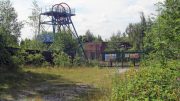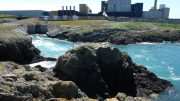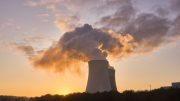Inadequate power generation capacities and the search for solutions
In 2023, Latvia experienced a positive year in terms of electricity generation, mostly due to favourable conditions for hydro energy generation, coming from large hydropower plants built in the previous century. Local generation in Latvia covered 88.3 per cent of the country’s electricity consumption (an increase of 21 percentage points from the previous year), which is the highest proportion since 2017. The remaining amount of electricity was imported from neighbouring countries. 77.6 per cent of the electricity produced in Latvia was generated from renewable energy sources, including energy from hydropower plants that cannot be seen as sustainable by today’s standards.
Even though the overall balance for 2023 shows a rather positive picture, Latvia is in need of more renewable and sustainable resource-based power-generating capacities for several reasons. Not every year is as generous for hydro energy as was 2023, and Latvia still relies significantly on fossil gas-generated power and heat. In 2023, 22.4 per cent of all generated electricity in Latvia came from fossil gas, which is a costly source of energy not only for our wallets, but also for the climate. In future, it is expected that electricity consumption will grow due to the electrification of heating and transport, as well as of industrial processes, which is much needed in order to reduce greenhouse gas emissions. This indicates two important needs: one is for more local renewable energy generation, and the other is for energy balancing, storage solutions and new interconnections with other EU regions. These would help decarbonise our energy sector, as well as bring down electricity costs.
The Ministry of Climate and Energy is responsible for finding solutions to these needs. Various projects are in progress or are planned. For instance, REPowerEU funds are financing the establishment of one of the most powerful electrical energy storage battery systems in Europe for energy balancing needs, which will be especially crucial when the Baltic states disconnect from the power grid with Belarus and Russia at the beginning of 2025.
However, the Ministry is also exploring opportunities for developing nuclear capacities. In a recently prepared informative report on nuclear energy development opportunities in Latvia, the Ministry identified two possibilities for nuclear energy development. One is to cooperate with Estonia in nuclear energy project development (either as an active developer or as an investor). The other is to develop small modular nuclear reactors (SMRs) in Latvia, independently from Estonia. The report concludes that the most desirable direction for Latvia seems to be cooperating with Estonia in one way or another, if the parliament decides to proceed with nuclear energy development at all. The presentation of the report to deputies on 12 March initiated discussions in the parliament. At the same time, discussions have just started in the Estonian parliament, where the creation of power-generating capacities is even more crucial due to the planned phase-out of oil shale. Estonian climate minister Kristen Michal stated that there are plans to prepare a nuclear energy law within the next five years pending parliamentary support.
The many risks of nuclear energy and incompatibility with climate crisis challenges
Despite objections from EU-level environmental organisations, the European Union’s Sustainable Finance Taxonomy delegated act on the environment and climate deem investments in nuclear energy as environmentally sustainable economic activities. However, there are various serious arguments as to why this cannot be considered environmentally sustainable and why choosing nuclear energy development in Latvia, as well as in Estonia, would be too risky.
From the point of view of energy system security, having electricity production in many smaller, geographically dispersed stations, rather than in one large complex, provides greater resilience in the event of natural disasters and military or terrorist threats. This is well illustrated by the Ukraine example, where Zaporizhzhia nuclear power plant has been used as a strategic object for Russian occupants, creating ongoing nuclear safety crises, and where the sabotaging of the Kakhovka dam has created a large-scale humanitarian, environmental and economic disaster.
Investing in SMRs would also be a great economic risk at the moment, as the total costs of such projects are not yet known. There is not yet any such station operating for commercial purposes anywhere. SMRs could be even more expensive than conventional nuclear power plants because they are less efficient due to reduced economies of scale, and because of the costs of deploying first-of-a-kind technologies; yet they still have similar challenges, such as safety requirements and the storage of radioactive waste. In the end, this could mean high electricity costs, a burden on society.
Another problematic aspect is the large time scale required for the implementation of nuclear energy projects. For conventional reactors, it is typically 15 to 20 years. In the case of SMRs, the industry claims that this period of time may be shorter, but one should be careful with the information provided by the industry itself, as its main goal is to sell this technology. In its estimates, the Ministry mentioned that the development of SMRs could take 15 years for Latvia, due to the extensive preparatory work that must be done, including the development of a regulatory framework and workforce preparation. However, this too may turn out to be an optimistic assessment.
The main problem with such a long development period is that we already need new renewable power-generating capacity now. If we allocate financial resources to a solution that will only come in 15 to 20 years, we divert investments away from the development of other technologies, which would provide the needed energy much more quickly; for example, wind, solar energy projects, industrial heat pumps, energy storage technologies, the creation of interconnections with other EU regions, and promotion of demand side flexibility. This delay would result in higher electricity prices, which, of course, would not improve Latvia’s competitiveness. However, more importantly, any delay in the transition to renewable resources contributes to global warming, which requires solutions now. Latvia also runs the risk of failing to meet the greenhouse gas emission reduction target, which would result in the need to purchase expensive emission quotas from other EU countries as 2030 approaches.
In addition, creating radioactive waste that must be handled under controlled conditions for up to tens of thousands of years is an excessive, unacceptable burden for future generations, given that we have other technologies available. Radioactive and toxic waste, which is created in large amounts in all stages of nuclear fuel cycle, from mine to reactor, is already creating serious environmental pollution and hazard to public health.
As a small country with limited financial and administrative resources, lengthy nuclear energy development from scratch seems a very daunting path, especially given the fact that Latvia already has a relatively high proportion of renewable energy and has great potential for the further development of this sector.
Maksis Apinis
April 24, 2024
Originally published by Bankwatch Network





